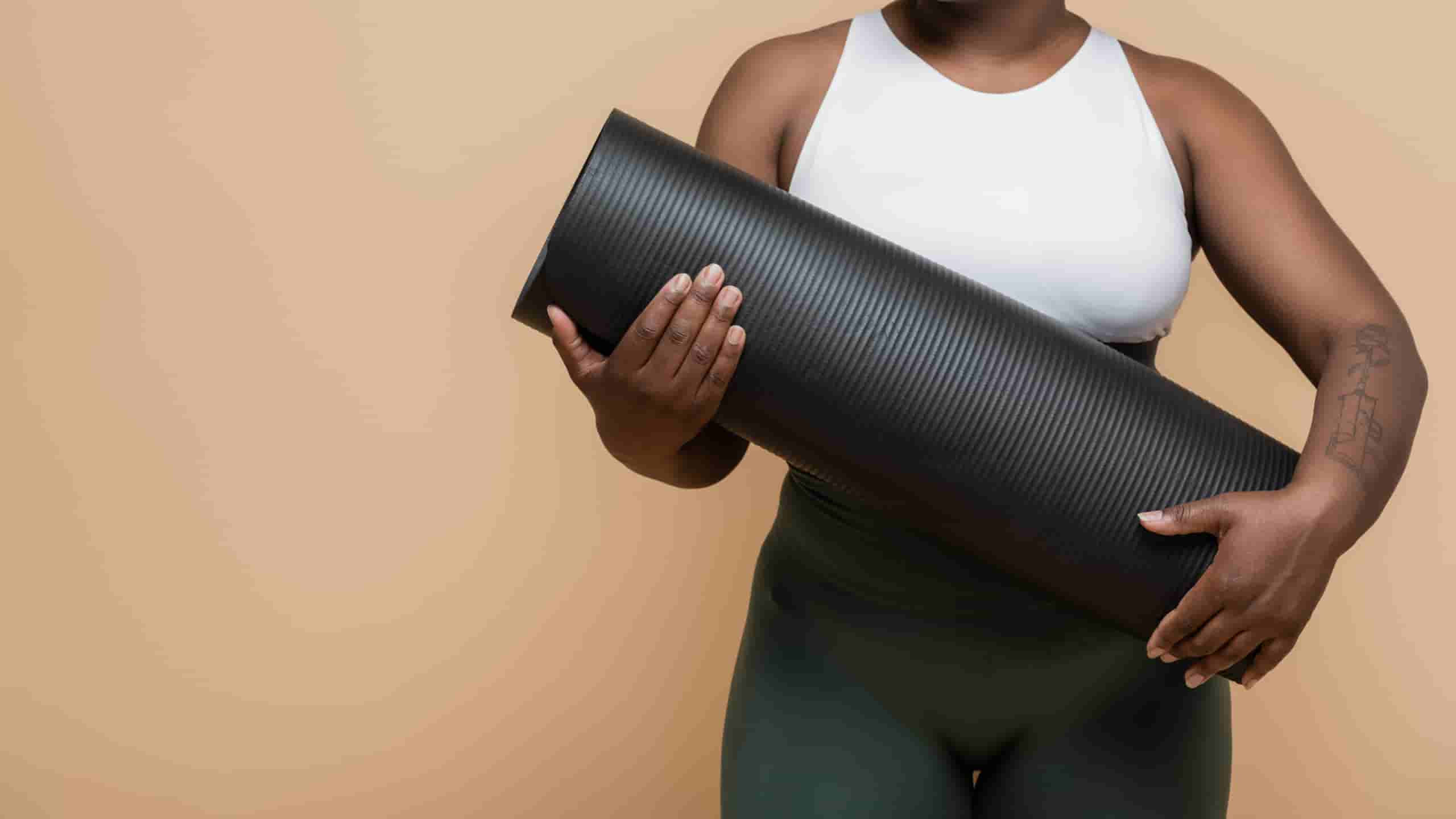

A grounding yoga mat can enhance this experience by providing a stable foundation for your practice. First, choose a quiet and clutter-free area in your home where you feel comfortable and at peace. This could be a corner of a room, a spot near a window with natural light, or even an outdoor space if weather permits. Next, set the mood by lighting candles, burning incense, or playing soft music to create a calming atmosphere. You may also want to incorporate elements such as crystals, plants, or sacred objects that hold personal meaning for you.
Choose a mat that feels supportive and comfortable for you, whether it's made of eco-friendly materials like cork or natural rubber, or has extra cushioning for joint support. Take a few moments to ground yourself before beginning your practice. Close your eyes, take deep breaths, and visualize roots growing from the soles of your feet into the earth below. Feel yourself connected to the energy of the earth beneath you.
Allow yourself to release any tension or distractions as you flow through poses that nourish both body and soul. Benefits of grounding yoga matsGrounding yoga mats offer numerous benefits for practitioners looking to deepen their practice and enhance their overall well-being. Firstly, grounding yoga mats help to establish a connection with the earth during your practice. This connection allows you to feel more stable and rooted, helping you to stay present and focused on the mat.
By grounding yourself, you can experience a sense of calmness and stability that can carry over into other areas of your life. Secondly, using a grounding yoga mat can help to reduce inflammation in the body. The earth's natural energy has been shown to have anti-inflammatory effects, which can be beneficial for those dealing with conditions like arthritis or chronic pain. By practicing on a grounding mat, you may experience less discomfort and stiffness in your joints.
This increased awareness of your body can lead to better alignment in poses and a reduced risk of injury during your practice. With improved balance and coordination, you may find that challenging poses become more accessible over time. Lastly, practicing on a grounding yoga mat can provide mental clarity and emotional stability.
By creating a peaceful environment for your practice, you may find it easier to let go of negative thoughts and emotions, leading to an overall sense of well-being both on and off the mat. Techniques for grounding yourself on a yoga matTo ensure a stable and balanced practice on your yoga mat, it is essential to ground yourself effectively. Here are some techniques to help you achieve a strong foundation:Press your feet firmly into the mat: Start by bringing awareness to your feet and pressing them down evenly into the mat.
This action will help create a solid base of support for the rest of your body during your practice. Engage your core muscles: By engaging your core muscles, you can stabilize your body and maintain proper alignment on the mat. This will not only help with balance but also prevent injuries as you move through different poses. Lengthen through your spine: Focus on lengthening through your spine from the tailbone to the crown of your head. This elongation will help improve posture and allow for better energy flow throughout the body.
These tools can provide additional support and stability as you explore different poses on the mat. Breathe deeply and mindfully: Finally, remember to breathe deeply and mindfully throughout your practice. By focusing on your breath, you can center yourself in the present moment and connect more fully with the earth beneath you. This conscious breathing will not only enhance your grounding but also bring a sense of calmness and focus to your yoga practice.
This connection allows us to feel supported and stable in our poses, creating a strong foundation for our practice. By staying connected to the earth, we are able to cultivate a sense of presence and mindfulness in each movement and breath. This awareness helps us to stay focused and fully engaged in the present moment, enhancing the overall benefits of our yoga practice. Feeling grounded also helps to release tension and stress from the body, allowing for a deeper sense of relaxation and ease.
Maintaining a connection to the earth can also improve our balance and stability during challenging poses. By rooting ourselves firmly into the ground beneath us, we are able to find strength and support in our bodies, enabling us to move with grace and confidence on our yoga mat. Grounding ourselves in each pose can also help us connect more deeply with our breath and energy flow. By drawing energy up from the earth through our feet or hands, we can channel this vital life force throughout our entire being, fostering a sense of vitality and renewal.

Staying connected to the earth not only benefits us physically and mentally but also spiritually. By tuning into the natural rhythms of the earth, we can tap into its wisdom and healing energy, deepening our spiritual connection and enhancing our overall well-being. Incorporating grounding practices into your yoga routine can have profound effects on your mind, body, and spirit. By staying connected to the earth during your practice, you can cultivate a greater sense of presence, balance, strength, and inner peace that will carry over into all aspects of your life. How to choose a grounding yoga matWhen looking for a grounding yoga mat, there are a few key factors to consider in order to find the best option for you. Material: Choose a yoga mat made of natural materials like rubber or jute, as they provide better grounding properties than synthetic materials.
Texture: Look for a yoga mat with a textured surface to help prevent slipping and enhance your connection to the ground. Size: Consider the size of the yoga mat based on your height and preference. A longer or wider mat may be more comfortable for taller individuals or those who prefer extra space. Color: While color may seem like a superficial factor, choose a color that resonates with you and promotes feelings of calmness and grounding during your practice. Brand: Research different brands and read reviews to find one that is known for producing high-quality grounding yoga mats that will last through many practices.
Grounding poses for stability and balance on your matGrounding poses for stability and balance on your mat are essential for a strong foundation in your yoga practice. These poses help you feel connected to the earth and establish a sense of stability and balance. Mountain Pose (Tadasana) is a great grounding pose that helps you focus on your alignment and posture. Stand tall with your feet hip-width apart, grounding down through all four corners of your feet. Engage your core, lengthen your spine, and relax your shoulders down away from your ears.
Warrior II (Virabhadrasana II) is another powerful grounding pose that builds strength in both the legs and core. Step one foot back into a lunge position, keeping your front knee stacked over your ankle. Ground down through the outer edge of your back foot while reaching out through your fingertips in opposite directions. Find balance by engaging both legs equally and gazing over your front hand.

Tree Pose (Vrksasana) challenges your balance while also grounding you through one leg at a time. Start by rooting down through one foot as you lift the other foot to either calf or inner thigh, avoiding placing it directly on the knee joint. Press palms together at heart center and find a focal point to help with balance. Feel the connection to the earth through your standing leg as you grow taller like a tree reaching towards the sky. Child's Pose (Balasana) is a restorative grounding pose that allows you to surrender to gravity and release tension in the body.
Lower hips towards heels as you extend arms forward with palms resting on the mat or stacked fists supporting forehead. Breathe deeply into the back body, feeling supported by mother earth as you ground down through hands, shins, and forehead on the mat. Incorporating these grounding poses into your practice will not only help improve stability and balance but also deepen your connection to yourself and the earth beneath you on your yoga mat. Incorporating mindfulness and meditation into your grounding practice on a yoga matIncorporating mindfulness and meditation into your grounding practice on a yoga mat can enhance the overall experience of your practice.
Mindfulness involves being fully present in the moment without judgment. When you step onto your yoga mat, take a few moments to center yourself and bring awareness to your breath. Notice any sensations in your body and observe any thoughts or emotions that arise without attaching to them. As you move through your asana practice, focus on each movement with intention and awareness.
Pay attention to the alignment of your body, the sensation of stretching or strengthening muscles, and the rhythm of your breath. By staying present in each moment, you can deepen your connection to yourself and cultivate a sense of grounding. Incorporating meditation into your yoga practice can further enhance this sense of connection and grounding. Take moments throughout your practice to pause and come back to your breath. You can also incorporate specific meditation techniques such as focusing on a mantra or visualizing a calming image to help quiet the mind. By incorporating mindfulness and meditation into your grounding practice on a yoga mat, you can create space for self-reflection and inner peace.
Remember that mindfulness and meditation are skills that require practice – they may not come easily at first but with consistent effort, they can become valuable tools for enhancing your yoga practice. Be patient with yourself as you explore these practices on the mat and notice how they enrich your overall experience. Ultimately, by incorporating mindfulness and meditation into your grounding practice on a yoga mat, you can deepen your connection to yourself, improve focus and concentration during practice, release tension in both body and mind, cultivate inner peace amid life's chaos - creating an overall sense of well-being both on and off the mat. Tips for creating a sacred space for grounding on your yoga matTo create a sacred space for grounding on your yoga mat, start by finding a quiet and clutter-free area where you can lay down your mat. This will help you establish a sense of peace and tranquility as you prepare to embark on your practice.
Soft blues, greens, and earth tones can help evoke feelings of serenity and connection to the natural world. Opt for natural materials like cotton or jute for a more grounded sensation beneath your feet and hands. Light a candle or burn some incense before beginning your practice to cleanse the energy in the space. The flickering flame or aromatic smoke can help center your mind and bring focus to your breath as you move through each pose. Play soft music or nature sounds in the background to further enhance the ambiance of your sacred space.
Set an intention for your practice by taking a few moments to visualize what you hope to achieve during this time on your mat. Whether it's finding inner peace, releasing tension, or cultivating gratitude, having a clear goal in mind can guide your movements and breath throughout the session. Practice mindfulness by focusing on each movement, breath, and sensation as you flow through your poses. Stay present in the moment without judgment or expectation, allowing yourself to fully experience the physical and emotional benefits of each posture. End your practice with gratitude by taking a moment to thank yourself for showing up on the mat today.

Grounding yoga mats are typically made of conductive materials like carbon-infused polyurethane or rubber, which allow for the transfer of electrons from the Earth to the body during yoga practice.
Yes, grounding mats for yoga come in various sizes, just like regular yoga mats. Some brands offer larger mats for more space during practice, while others are designed for portability and ease of use.
A grounding yoga mat, also known as an earthing yoga mat, is designed to connect the body to the Earth's natural energy by providing a conductive surface. This helps neutralize free radicals and can promote physical and emotional well-being during yoga practice.